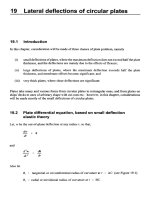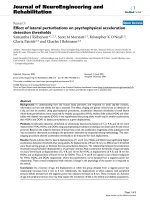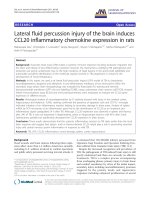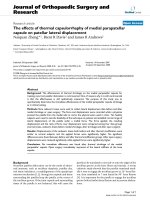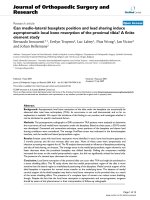LATERAL DEFLECTION OF CIRCULAR PLATED
Bạn đang xem bản rút gọn của tài liệu. Xem và tải ngay bản đầy đủ của tài liệu tại đây (556.72 KB, 34 trang )
I9
Lateral deflections of circular plates
19.1 Introduction
In this chapter, consideration will be made of three classes of plate problem, namely
(i)
small deflections ofplates, where the maximum deflection does not exceed half the plate
thickness, and the deflections are mainly due to the effects of flexure;
(ii)
large deflections of plates, where the maximum deflection exceeds half the plate
thickness, and membrane effects become significant; and
(iii)
very thick plates, where shear deflections are significant,
Plates take many and various forms from circular plates to rectangular ones, and from plates on
ships' decks to ones of arbitrary shape with cut-outs etc; however,
in
this chapter, considerations
will be made mostly of the small deflections of circular plates.
19.2
Plate differential equation, based on small deflection
elastic theory
Let,
w
be the out-of-plane deflection at any radius
r,
so
that,
and
d2w
-
de
dr
'
dr
Also let
R,
=
tangential or circumferential radius of curvature at
r
=
AC (see Figure
19.1).
R,
=
radial or meridional radius
of
curvature at
r
=
BC.
Plate differential equation, based
on
small
deflection elastic theory
459
Figure
19.1
Deflected
form
of
a
circular
plate.
From standard small deflection theory of beams (see Chapter 13) it is evident that
=
1i”-
=
l/
de
dr
(19.1)
dr2
Rr
or
&
Rr
dr
(19.2)
1-
From Figure 19.1 it can be seen that
R,
=
AC
=
rl8
(19.3)
or
8
R,
rdr r
(19.4)
1-
lh
-
Let
z
=
the distance of any fibre
on
the plate from its neutral axis,
so
that
1
(19.5)
=-
E~
=
radial strain
=
-
-
E
(or
-
YO,)
Rr
460
Lateral
deflections
of
circular
plates
and
E,
=
circumferential strain
=
-
z1
=
-
(ai
-
vor)
R,
E
From equations (19.1) to (19.6) it can be shown that
where,
a,
=
radial stress due to bending
a,
=
circumferential stress due
to
bending
The tangential of circumferential bending moment per unit radial length
is
de
z3
+‘I*
E
=
-
(1
-
v’)
(:
+
7)
[TI-,,’
-
Et3
-
12(1
-
v’)
therefore
MI
=
D(:+v$)
=
.I + )
1
dw
d’w
r
dr dr’
(19.6)
(1
9.7)
(19.8)
(1
9.9)
where,
t
=
plate hckness
Plate differential equation, based
on
small deflection elastic theory
46
1
and
=
flexural rigidity
Et
3
D=
12(1
-
Y’)
Sdarly, the radial bending moment per unit circumferential length,
Mr
=
D($+:)
=
D[&+&)
dr’ rdr
(19.10)
Substituting equation (19.9)
and
(19.10) into equations (19.7) and (19.8), the bending stresses
could be put in the following
form:
(s,
=
12
M,
x
z
I
t’
and
(J
=
12~,
x
zit3
(19.1 1)
and the
maximum
stresses
6,
and
6,
will occur at the outer surfaces
of
the plate (ie,
@z
=
*IC).
Therefore
(19.12)
2
et
=
6Mt
It
br
=
6Mr
I
t’
and
(19.13)
The plate differential equation can now be obtained
by
considering the equilibrium of the plate
element of Figure 19.2.
Figure
19.2
Element
of
a
circular
plate.
Takmg moments about the outer circumference
of
the element,
(Mr
+
6M,)
(r
+
6r)
69
-
M,
r6q
-
2M,
6r
sin
-
6q
-
F
r
6q6r
=
0
2
462
In
the limit, this becomes
Lateral deflections
of
circular plates
dMr
M,+r M,-Fr
=
0
dr
Substituting equation (19.9) and (19.10) into equation (19.14),
or
which can be re-written in the form
(19.14)
(19.15)
where
F
is the shearing force
/
unit circumferential length.
Equation (19.15) is
known
as the plate differential equation for circular plates.
For a horizontal plate subjected to a lateral pressure
p
per unit area and a concentrated load
W
at the centre,
F
can be obtained from equilibrium considerations. Resolving ‘vertically’,
2nrF
=
nr’
p
+
W
therefore
W
2
2nr
F
=
+
-
(except at
r
=
0)
Substituting equation (19.16) into equation (19.15),
(19.16)
therefore
Plate differential equation, based
on
small
deflection elastic theory
463
since,
&-e
dr
w
=
/e
dr
+
C,
hence,
4
wr c1r2
w=-
pr
+-(~n
r-1)+-+c2
In
r+C3
640
8xD
4
Note that
2
2
7
r-
2
r
=
-1n
r
-
-
+
a constant
2
4
(19.17)
(19.18)
(19.19)
Problem
19.1
Determine the
maximum
deflection and stress in a circular plate, clamped
around
its
circumference, when it is subjected to a centrally placed
concentrated load
W.
464
Lateral deflections
of
circular
plates
Solution
Putting
p
=
0
into equation
(1
9.18),
Wr Clr2
w
=
-(hr-l)+- +C2 Inr+C3
8x0
4
asdw/drcamotequal-at r
=
0,
C,
=
0
-w=o
atr= R,
-
-
my
dr
therefore
and
WR WR
WR
C,R
4nD 4nD 8nD
2
0
=
-InR +-+-
Hence,
W
4nD
Cl
=
-(1
-2
In
R)
WR
-
WR2 WR2 WR2
In
=
hR+ +-
WR
8nD 8nD 16nD 8nD
1
6nD
c3
=
WR
hR+-
w=-
WR Inr + Wr2 Wr2 Wr2
8nD 8nD 16110 8x0 16nD
or
w
=
-1
WR
1
-
-
r2
+
-
2R2
.(;)I
16x0 R2 R2
The
maximum
deflection
(6)
occurs at r
=
0
Plate differential
equation,
based
on
small deflection elastic theory
465
WR
’
*=-
16x0
Substituting the derivatives of
w
into equations (19.9) and (19.10),
M,
=
[I
+
In
(;)
(1
+
41
4n
MI
M,
=
-
v+(l +v)
In
4x
w[
Problem 19.2
Determine the maximum deflection and stress that occur when a circular plate
clamped around its external circumference is subjected to a uniform lateral
pressure
p.
Solution
From equation (19.18),
4
C,r2
w
=
E+-
+
C,
In
r
+
C,
640
4
dw
3
C,r
C,
-
=
E+-+-
dr
160
2
r
and
d2w
-
3pr2
CI
c2
-+
dr
’
160
2
r2
at
r
=
0,
-
+
-
therefore
C,
=
0
&
atr
=
R,
w
=
-
&-o
-
dr
therefore
466
Lateral
deflections
of
circular plates
therefore
-pR2
c,
=
-
80
PR
c,
=
-
640
therefore
2
640
Substituting the appropriate derivatives of
w
into equations
(1
9.9)
and
(1
9.
IO),
M,
=
-
pR2
1
-(I
+
v)
+
(3
+
v)
-
16
-(1
+
v)
+
(1
+
3v)
-
16
R2
r2
1
Maximum deflection
(6)
occurs at
r
=
0
G=-
PR
640
(19.20)
(19.21)
(19.22)
(19.23)
By
inspection
it
can be seen that the maximum bending moment is obtained from
(19.21),
when
r
=
R,
i.e.
hr
=
pR’I8
and
=
6k,
It2
=
0.75pR2
It2
Plate differential equation, based
on
small
deflection elastic theory
467
Determine the expression
for
M,
and
M,
in
an annular disc, simply-supported
around its outer circumference, when it is subjected to a concentrated load
W,
distributed around
its
inner circumference, as shown
in
Figure
19.3.
Problem
19.3
Figure
19.3
Annular
disc.
W
=
total load around the inner Circumference.
Solution
From equation
(19.18),
Wr
2
8KD 4
C,r2
+
C,
In
r
+
C,
w
=
-(Inr-l)+-
at
r
=
R,,
w
=
0
or
(19.24)
WR;
c7
0
=
-(In
R2-1)+ !-R;+C2
In
R2+C3
8xD
4
Now,
(19.25)
Wr
Wr C,r C,
dr 4nD
8x0
2 r
dw-
-(In
r
-
1)
+
-
+
-
+
-
and,
2
dw
W
w
WCC,
(19.26)
-
-(ln
r-l)+-+-+L
dr2
4xD
4xD
8xD
2
r2
A
suitable boundary condition is that
468
Lateral deflections
of
circular plates
M,
=
0
at
r
=
R,
and
at
r
=
R,
but
therefore
W
3w
c, c,
-
(In
Rl-l)
+
-+-
-
-
4nD 8nD
2
R:
R,
4xD
and
Solving
equations (19.27)
and
(19.28) for
C,
and
i2,
and
C,
is not required to determine expressions for
M,
and
M,.
Hence,
M,
=
D(W/8nD)
{(l
+
v)2
In
r
+
(1
-
v)}
(1
9.27)
(19.28)
(19.29)
(19.30)
(19.31)
Plate differential equation,
based
on
small
deflection elastic theory
469
and
M,
=
D(WI8nD)
((1
+
v)2
In
r
-
(1
-
v)}
+
(~,/2)
(1 +
v)
+
(c2/r2)
(1
-
v)
(19.32)
Problem
19.4
A flat circular plate of radius
R,
is simply-supported concentrically by a tube
of radius
R,,
as
shown
in
Figure 19.4. If the 'internal'
portion
of the plate
is
subjected to a uniform pressurep, show that the central deflection
6
of the plate
is given by
6
=
"{3+2[?)2(L2)]
640
Figure
19.4
Circular
plate
with
a
partial
pressure
load.
Solution
Now the shearing force per unit length
F
for
r
>
R,
is
zero, and for
r
<
R,,
F
=
prl2
so
that the plate differential equation becomes
r
>
R,
c_________
r
<
R,
________
~
-___
=o
-
d{ld(r:)}=g
dr r dr
~"(r:)
=E+A
=B (19.33)
r dr
For continuity at
r
=
R,,
the
two
expressions
on
the right of equation (19.33) must be equal, i.e.
470
Lateral
deflections
of
circular
plates
or
or
or
+A
=
B
PR:
-
40
g=-
40
+(rz)
=
40
which
on
integrating becomes,
dw
-
pr4 Ar2
+
dr
160
2
r-
-
-+-
my
dr
at
r
=
0,
-
+
m
therefore
C
-
pRjr
+
Ar
40
80
2
=o
(19.34)
(1
9.35)
For
continuity at
r
=
R,,
the value of the slope must be the same from both expressions on the
right
of
equation
(19.35),
i.e.
therefore
Plate differential equation,
based
on small
deflection elastic theory
47
1
F
=
-pR:
l(16D)
(19.36)
therefore
Ar
_
dw
-
pr
+-
dr
160
2
whch on integrating becomes
pr4
Ar2
640
4
w
=-+-+G
(19.37)
(19.38)
-
pR:r2
Ar2
Rf
r+H
+
160
4
160
Now, there are three
unknowns
in equation
(19.38),
namely
A,
G
and
H,
and therefore, three
simultaneous equations are required to determine these
unknowns.
One equation can be obtained
by considering the continuity of
w
at
r
=
R,
in equation
(19.38),
and the other
two
equations can
be obtained by considering boundary conditions.
One suitable boundary condition is that at
r
=
R,,
M,
=
0,
which can be obtained by
considering that portion of the plate where
R,
>
r
>
R,,
as follows:
dw
-
PR:r
Ar PRP
dr
80
2
16Dr
-++
Now
A
2
(1
+
v)
+
-
(1
+
v)+
Now, at
r
=
R,,
M,
=
0;
therefore
(19.39)
(1
-
4
-
(1
+
v)
=
(1
+
v)
-
-
A
PR: PRP
2
8D
16DRi
472
or
Lateral deflections
of
circular plates
(19.40)
Another suitable boundary condition
is
that
at
r
=
R,,
w
=
0
In
this
case, it will
be
necessary to consider
only
that portion of the plate where
r
c
R,,
as
follows:
pr4 Ar2
+
640
4
w
=
-+-
at
r
=
R,,
w
=
0
Therefore
PR,~
AR:
0
=
-+-
+G
640
4
or
=
-+[!$+L&(fi)}$
-PR,4
640
or
G
=
L[3+2[2)2(e)} PR4
640
(19.41)
The central deflection
6
occurs at r
=
0;
hence,
from
(19.41),
Plate differential equation,
based
on
small
deflection elastic theory
473
6=G
6
=
"6+2(2]2(J2)}
(19.42)
640
0.1 15
WR2/(ET3);
-
w
[
0.621
In
(f)
-0.436
+
0.0224
(!).I}
[
t2
Problem
19.5
A
flat circular plate of outer radius
R,
is
clamped firmly around its outer
circumference.
If
a load
Wis
applied concentrically to the plate, through a tube
of
radius
R,,
as shown
in
Figure 19.5, show that the central deflection
6
is
6
=
L(.ih(!L]*+l?:-R/jJ
16x0
Figure
19.5
Plate under
an
annular load.
Solution
When
r
<
R,,
F
=
0,
and when
R,
>
r
>
R,,
F
=
W/(Zm),
so
that the plate differential
equation becomes
+
- -
-
-
-
_
-
,.<R,
________
+-__-
r
>
R,
-w
i{Ld(r$)}
=
0
dr r
2nD
474
or
Lateral deflections
of
circular
plates
id(,$) r
=
A
or
d(r:)
=
Ar
-
~nr+~
2nD
Wr
In
r
2xD
-
+
Br
(19.43)
From continuity considerations at
r
=R,,
the
two
expressions on the right of equation
(1
9.43) must
be equal, i.e.
W
2nD
A
=
-hR,
+
B
On integrating equation
(1
9.43),
mV
-
Ar2
dr
2
2
r +C
or
dw
Ar
C
dr
2
r
+-
-
at
r
=
0,
-
+
m
therefore
C
=
0
dr
From continuity considerations for
dw/dr,
at
r
=
R,,
(19.44)
(19.45)
(19.46)
On integrating equation
(1
9.46)
or
w=-
+G
2
Wr'
Br
-(In
r-l)+-+F
In
r+H
8x
D
4
(19.47)
Plate differential equation,
based
on
small deflection elastic theory
475
From continuity considerations for
w,
at
r
=
R,,
Arf
2
+G
-
BR:
+
F
In
R,
+
H
(19.48)
WR;
8nD
4
-
(In
R,-I)+-
In
order to obtain the necessary number of simultaneous equations to determine the arbitrary
constants, it will be necessary
to
consider
boundary considerations.
at
r
=
R,,
-
h=o
dr
therefore
Also, at
r
=
R,,
w
=
0;
therefore
WR;
BR,~
0
=
-
(h
R,-
1)
+
-
+
F
In
(R2)
+
H
8nD 4
Solving equations (19.46), (19.48), (19.49) and (19.50),
(19.49)
(19.50)
(19.5
1)
W
8nD
H
=
{-R,2/2
-
R:/2
+
R:h
(R?))
and
476
Lateral deflections
of
circular plates
WR: WR:
8aD 8nD
In
(4)
+
H
G
=
+-
+
R:
ln
(41
=
-WR:
+
WR: ’.(R*)
w
(3
-
g
8nD 8aD
2
2
W
16aD
=
-
(-2R:
+
2Rf
In
(R,)
+
Ri
+
R:
-
2R:
In
&)}
G
=
zhfln[:)
2
+($ :I
6
=
G
=
z[:In[:)
2
+(R;-R:i
16nD
6
occurs at
r
=
0,
i.e.
16nD
19.3
Large deflections
of
plates
If
the
maximum
deflection of a plate exceeds half the plate thickness, the plate changes to a
shallow shell, and withstands much of the lateral load as a membrane, rather
than
as a flexural
structure.
For example, consider the membrane shown
in
Figure 19.6, which
is
subjected to
uniform
lateral pressure
p.
Figure
19.6
Portion
of
circular
membrane.
Let
w
=
out-of-plane deflection at any radius
r
u
=
membrane tension at a radius
r
t
=
thickness of membrane
Large
deflection
of
plates
477
Resolving vertically,
or
P'
dr
2ot
-
or
at
r
=
R,
w
=
0;
therefore
i.e.
6
=
maximum deflection of membrane
G
=
-pRZ/(4ot)
The change
of
meridional (or radial) length is given by
where
s
is
any length along the meridian
Using Pythagoras' theorem,
61
=
/
(my'
+
dr2)"
-
jdr
(1
9.52)
Expanding binomially and neglecting hgher order terms,
478
Lateral deflections
of
circular
plates
61
=
[[l
+
‘(7?1dr
2
dr
-
[dr
(19.53)
2
=
if($)
2
dr
Substituting the derivative
of
w,
namely equation (19.52) into equation (19.53),
2
61=
IfR(E)
20
dr
=
p
’
R
3/(24$t
’)
but
or
i.e.
but
0
=
pR’J(4~)
From equations (19.55) and (19.56),
P=
3(1
-
V)
According to small deflection theory
of
plates (19.23)
P
=
-(x)
640
G
R3
(19.54)
(19.55)
(19.56)
(19.57)
(19.58)
Large
deflection
of
plates
479
Thus, for the large deflections of clamped circular plates under lateral pressure, equations (19.57)
and (19.58) should be added together, as follows:
3
(19.59)
640
GJ
8
p
=
F(x)
+
3(1
-v)(i)
(:)
If
v
=
0.3, then (19.59) becomes
&
=
(!)
f
+
0.65
(!)}
(19.60)
64Dt
where the second term in (19.60) represents the membrane effect, and the first term represents the
flexural effect.
When
GJ/t
=
0.5,
the membrane effect is about 16.3% of the bending effect, but when
GJ/t
=
1,
the membrane effect becomes about
65%
of the bending effect. The bending and membrane
effects are about the same when
GJ/t
=
1.24.
A
plot of the variation of
GJ
due to bending and due
to the combined effects of bending plus membrane stresses, is shown in Figure 19.7.
Figure
19.7
Small
and large deflection theory.
19.3.1
Power
series
solution
This method of solution, which involves the use of data sheets, is based on a power series solution
of
the fundamental equations governing the large deflection theory of circular plates.
480
Lateral deflections of circular plates
For a circular plate under a uniform lateral pressure
p,
the large deflection equations are given by
(19.61)
to
(19.63).
d
;
tur)
-
a*
=
0
(19.61)
(19.62)
(19.63)
Way'
has
shown that to assist in the solution
of
equations
(19.61)
to
(19.63),
by the power series
method, it will be convenient to introduce the dimensionless ratio
6,
where
6
=
r/R
r
=1;R
or
R
=
outer radius of disc
r
=
any value of radius between
0
and
R
Substituting for r int
(19.61):
or
Inspecting
(19.64),
it can be seen
that
the
LHS
is dependent
only
on
the slope
0.
Now
(19.64)
5Way,
S.,
Bending
of
circular plates with large deflections,
A.S.M.E
APM-56-12,
56,1934.
Large
deflection
of
plates
48
1
whch, on substituting into (19.64), gives:
but
are all dunensionless, and
hs
feature will be used later on in the present chapter.
Substituting
r,
in
terms
of
1;
into equation (19.62), equation (19.66) is obtained:
Similarly, substituting
r
in terms of
6
equation (19.63), equation (19.67) is obtained:
(19.66)
(19.67)
Equation (19.67) can be seen to be dependent ocly on the deflected form of the plate.
dimensionless form by introducing the following dimensionless variables:
The fundamental equations, which now appear
as
equations (1 9.65) to (1 9.67), can be put into
X
=
r/t
=
CWt
W
=
w/r
u
=
u/t
S,
=
a,/E
S,
=
CJ~
/E
S,
=
p/E
(19.68)
482
Lateral deflections
of
circular plates
or
w
=
Jedx
Now
from
standard
circular plate theory,
I
and
Hence,
1
sri
=
2(1
-
v')
(%
+
:)
and
s,
I
=
'
("2)
2(1
-
v')
x
Now
from elementary two-dimensional stress theory,
uE
-
o[
-
vo,
r
or
u
=
X(S,
-
VSr)
(19.69)
(19.70)
(19.71)
(19.72)
(19.73)
where
u
is the in-plane radial deflection at
r.
equations take the
form
of
equations (19.74) to (19.76):
Substituting equations (19.68) to (19.73) into equations (19.65) to (19.67), the fundamental

